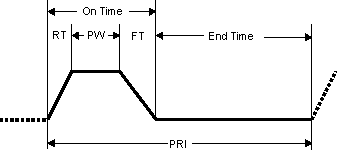
This topic describes the minimum times supported when generating a pattern with a single pulse.
The figure below shows how the application views a single pulse. It provides individual control over the rise time, the fall time, the pulse width and the pulse repetition interval. The rise time, pulse width, and fall time combine to form the pulse on time. The pulse on time is an important value in that it is used to generate a marker signal that is used to drive the pulse modulator in the signal generator. Driving the pulse modulator insures a pulse on off ratio of at least 80 dB. The I/Q signal alone provides a pulse on off ratio of about 55 dB. The rise time, fall time, and pulse width can be set to any value, including zero. However, the timing resolution is tied to the Arb Sampling Rate.
The PRI timing resolution for a single pulse is tied to the Arb sample rate and the Arb waveform granularity. The PSG/MXG/EXG/ESG internal Arbs have a waveform granularity of 1. The N8241A/N6030A/M9330A family of Arbs has a waveform granularity of 8 and the M8190A Arb has a waveform granularity of 48.
The single pulse PRI timing resolution is:
|
PSG/ESG Arb |
= 10 ns |
(1/100 MHz) |
|
MXG B |
= 5 ns |
(1/200 MHz) |
|
EXG B |
= 6.7 ns |
(1/150 MHz) |
|
M8190A |
= 12 ns |
(48/4 GHz) |
|
N8241A/N6030A/M9330A |
= 6.4 ns |
(8/1.25 GHz) |
The pulse edge times and the pulse on times are independent of the Arb waveform granularity and can be set to any value including zero. Setting the edge times to zero will result in overshoot and ringing. The actual edge times and on times will be rounded to the sample period resolution.
The period after the pulse on time is labeled “End Time” in the figure. The end time is required to re-align the marker signal used to drive the pulse modulator with the I/Q waveform data. The minimum end is only required on the last item in the signal pattern. In this case since there is only one pulse in the pattern, the end time effectively sets the minimum PRI. The amount of off time needed at the end of the signal (End Time) is approximately 130ns. The actual required End Time is hardware specific. The minimum PRI for the PSG/MXG/EXG/ESG internal Arbs is limited by the minimum segment size of 60 sample points.
|
|
PRI |
End Time |
Width1 |
|---|---|---|---|
|
PSG/ESG (100 MHz) |
610 ns |
130 ns |
30 ns |
|
MXG B (200 MHz) |
310 ns |
130 ns |
15 ns |
|
N8241A/N6030A/M9330A (1.25 GHz) |
150 ns |
140 ns |
10 ns |
|
M8190A (4 GHz) |
125 ns |
120 ns |
5 ns |

|
PRI |
Pulse Repetition Interval |
|
PW |
Pulse Width (100% Amplitude Time) |
|
RT |
Rise Time (0-100% Amplitude Time) |
|
FT |
Fall Time (100-0% Amplitude Time) |
|
On Time |
(RT + PW + FT) |
|
End Time |
(PRI – On Time) Only applies to the last pulse in a Pattern. |
When the Pulse shape is Custom Profile or Custom I/Q, the rising edge and falling edge times are assumed to be zero. The pulse On Time is equal to the Custom Profile or Custom I/Q data.
1. The minimum pulse widths shown here require the correct hardware configuration, the correct options (1E6 or UNW) and a correct pulse modulation alignment. Only the PSG signal generator is capable of these minimum pulse widths when using the pulse modulator. The ESG signal generator pulse modulator has rise and fall times of about 100 ns. Disabling the pulse modulator makes it possible to generate narrower pulses at the cost of reduced on/off ratios.